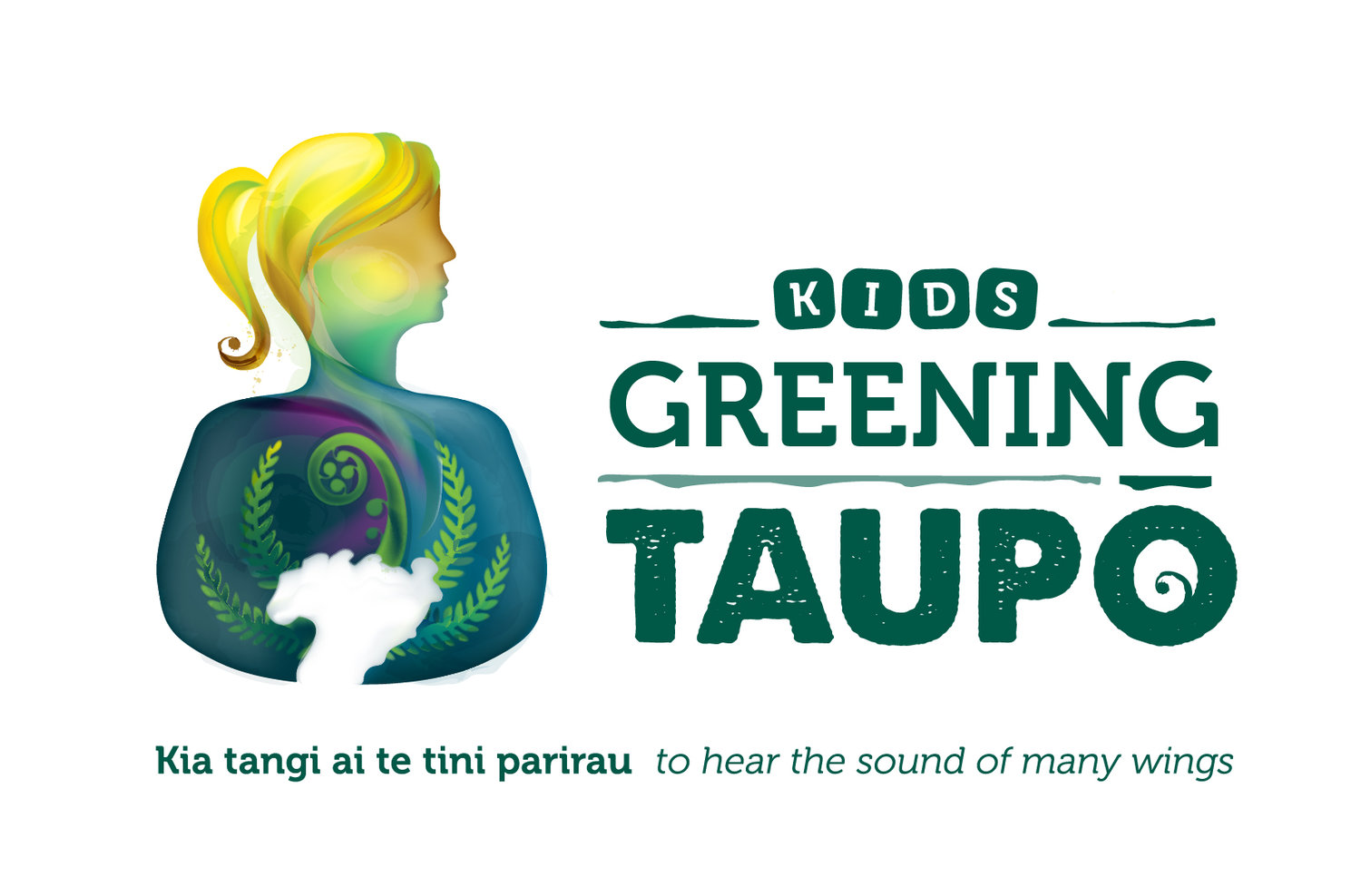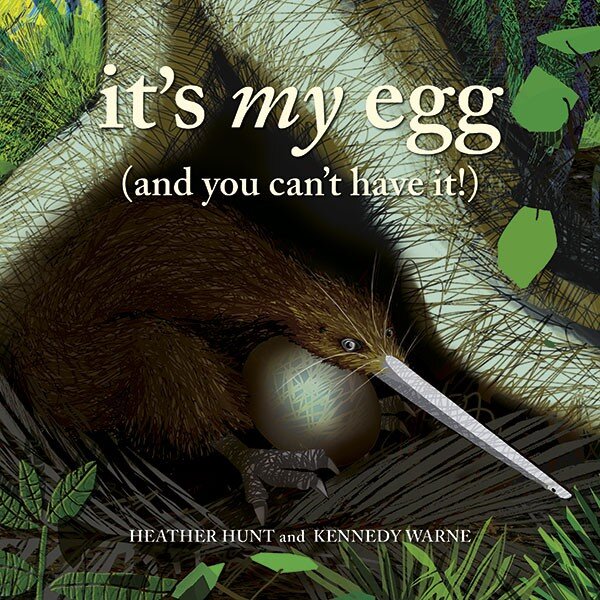Kiwi Conservation
Nau Mai! Welcome to the Kids Greening Taupo Online Nature Classroom!
This Online Nature Classroom is all about kiwi (birds)
AN INTRODUCTION TO THE famous kiwi
Living in Aotearoa everyone knows about our national icon- the kiwi- we New Zealanders are even known as kiwis!
So what is so special about this bird?
This flightless bird may look like the outside of the kiwifruit- fluffy and brown, however unlike the kiwi fruit, the kiwi bird has a long beak with nostrils right at the end, big strong legs with claws, tiny stumps for wings (vestigial wings) and makes a loud chirping or grunting call which can be heard up to 1.5km away! Out of all birds around the world, kiwi have the second largest olfactory bulb (part of brain used to process smells). They can also sense the movement of bugs and other critters up to 3cm under the ground! This is extremely important when finding their food, as they are active during the night (nocturnal). Kiwi live in burrows under large trees, in holes in the ground and under shrubs and ferns.
Kiwi are endemic (only found naturally in Aotearoa). There are five species and 10 sub-species of kiwi currently known. They have many similar features to typical mammals including heavy marrow-filled bones (unlike birds that fly). They have thick skin, large nasal passages (for smell), visible ear holes, large eggs, and the chicks are hatched as mini-adults, covered in feathers and able to forage for food.
Being flightless, kiwi are extremely vulnerable to introduced mammalian predators/pests. In the wild only 10% of kiwi chicks survive to six months.
Kiwi conservation:
We are extremely lucky in Taupō to have Wairakei Golf + Sanctuary, a predator proof golf course providing a safe haven for kiwi, takahē and kārearea (NZ Falcon). This sanctuary operates as an Operation Nest Egg (O.N.E) kiwi crèche, and in October 2019 the Crombie Lockwood Kiwi Burrow opened. Since the opening, 20 kiwi chicks have hatched at the kiwi burrow. Our Kids Greening Taupō Rangers (ecological experts) were lucky enough to have a close up experience with kiwi in March at Crombie Lockwood. This was thanks to the Kiwi Contact programme, a partnership between Kiwis for Kiwi, Contact Energy, and Wairakei Golf + Sanctuary, run in conjunction with Kids Greening Taupō with support from the Department of Conservation.
*Check out this really cool video that Brittany from Rakiura (Stewart Island) shared with us. It is a male and female kiwi having a duet on her walk to work one morning. How cool is that!
Thanks to predator free sanctuaries, operation nest egg programmes and predator free movements including trapping, kiwi have a fighting chance.
Crombie Lockwood kiwi incubation facility introduction video:
Our ‘Fill your Kete’ section will provide you with some fun nature activities based around our topic. As this theme is kiwi, our activities are based on their unique traits, lifestyle, threats, conservation and cultural significance.
Nocturnal Adventures
Kiwi are active during the night time (nocturnal). They use this time to forage (search) for food; tapping at the ground to find juicy bugs, as well as finding berries and plants to eat. That’s right, kiwi are omnivores- they eat plants and creatures (in this case bugs).
Tonight your task is to explore your backyard or local green space with your whānau by torchlight. Watch this VIDEO to start off.
What can you hear? Although you probably won’t hear kiwi unless you live right next to a native forest or kiwi sanctuary, you might be lucky enough to hear a ruru (morepork). Listen to some common night-time bird sounds HERE. Kiwi calls are used to mark territory and to communicate with a partner over long distances.
Can you hear any bugs? Or creatures moving around under the cover of darkness?
What can you see? Make sure to look really closely at the leaves of plants (including underneath them), the ground, and in piles of wood! This is a great time for spiders to be building their webs too, so keep an eye out for this.
Lots of other creatures are also awake when it is dark, including many of Aotearoa’s introduced predator species such as hedgehogs, stoats, possums and cats. Check out this incredible VIDEO of a kiwi defending its nest against a possum. It helps that kiwi have extremely strong legs and quick reactions!
Curiosity Questions
Do you think kiwi deserve to be New Zealand’s national bird and most famous animal?
Do some research to find out what makes kiwi so unique and special, and then tell us whether they deserve to be our national bird, or not. We’d love to hear your decision and the reasons that you have to justify your answer!
Do a piece of persuasive writing, write a speech or make a video to explain your decision.
Threats
Kiwi numbers dropped rapidly after humans arrived in Aotearoa. The sound of millions of kiwi used to be heard across New Zealand at night. Now, very few New Zealanders will ever see or hear a kiwi in the wild. 95% of chicks that hatch in the wild will be killed before they are a year old.
Why are they so threatened? What makes kiwi a vulnerable animal? What can we do to help them?
Research and share your findings in a poster or video. Spread the message about how we can help save our national bird.
Helpful resources: Understanding Kiwi-Biology and Behaviour , Threats to Kiwi PDF , Video all about kiwi
Make a Paper Mâché Kiwi Egg
Kiwi lay the biggest egg, in proportion to their body size, of any bird. The egg takes up to 20% of the female’s body size. That’s like a person giving birth to a 4 year old child! In the last few days before the female kiwi lays her egg, it takes up so much space inside her that she is unable to eat. Brown kiwi and little spotted kiwi females lay their egg, and then head off to feed and leave it with the male to look after. Other kiwi species share the incubation between the female and male kiwi. Watch this fascinating VIDEO about kiwi and their special eggs.
Challenge: Be a Kiwi Mum for a while! Weigh yourself and then work out what 20% of your body weight is. Fill a backpack with the equivalent weight and carry it around in front of you. How long did you manage to do it for? How did it feel?
Activities:
Create your Korowai
Kiwi hold a lot of cultural significance to Māori. They are known as the eldest child of Tāne Mahuta, the atua (god) of the ngāhere (forest). In our Birds Online Nature Classroom we learnt that the kiwi stepped up to save the ngāhere from the bugs, when all other birds declined Tāne’s cries for help. Tāne in turn gave the kiwi strong legs for speed, sharp claws for protection and scratching the ground, a long beak to dig holes in the soil for food, camouflaged feathers to hide away from predators roaming the sky and he reduced the kiwi’s wings as they would no longer be required living on the forest floor.
Kiwi feathers are special because they do not have barbs to link feathers together like the birds that fly. Kiwi feathers form a warm, fluffy layer of protection.
Kahu kiwi are a form of korowai (a tradition Māori woven cloak) that use kiwi feathers. After a kiwi dies, from predation or natural causes a kahu kiwi may be made to honour the mauri (life force) of the bird.
Watch this VIDEO to learn more about kahu kiwi.
Now it is your turn to create a korowai from paper or leaves. Here is a template feather stencil. If you don’t have access to a printer, why not draw feathers, or use leaves from outside instead?
Does your korowai tell a story?
KI TE PANUI/ TO READ
This ki te Panui section is based on kiwi.
Head to the section below for the read aloud story, It's My Egg (and You Can't Have It!).
If you already have this book make sure you head outside to connect to nature whilst enjoying it!
After reading/listening to the book make sure to try the follow up kiwi burrow activity.
In each Online Nature Classroom we will give book suggestions along with at least one video read aloud.
Our recommendation is It's My Egg (and You Can't Have It!).
Watch the read along below-
Follow up activity:
Make a kiwi burrow
Watch this VIDEO of Ruud Kleinpaste talking about kiwi habitats.
Then have a go at making your own kiwi burrow! What will you need to make it? Have you got shelter? Are there things around you that you can eat? Where would you get water from if you were a kiwi living in your burrow? Can you make an entrance to your burrow and disguise it? Have you got a nice soft nest to sit on inside your burrow? You might need to collect leaves and sticks to build your kiwi home. Have fun!
Extra challenge: Take action and get involved in helping New Zealand become predator free! If you would like to help protect our native birds, like kiwi, find out if there is a trapline near you that you could volunteer to help with. Or, you could get a trap to set up in your backyard. Everything that you need to know can be found on the Predator Free New Zealand website.



















